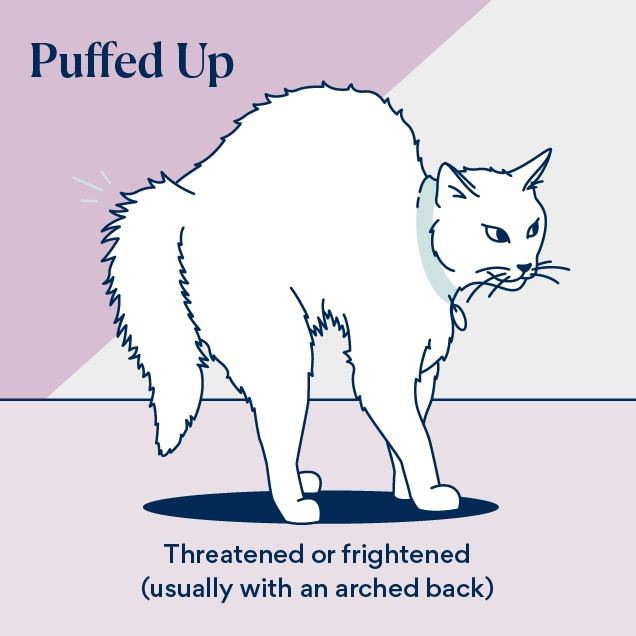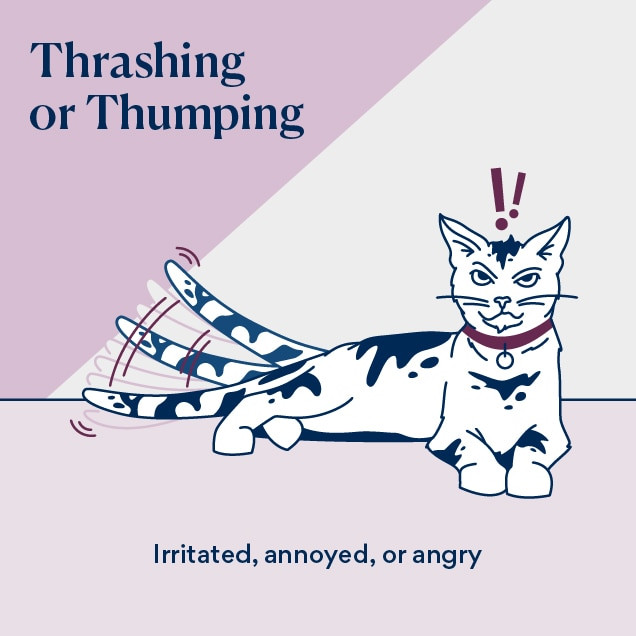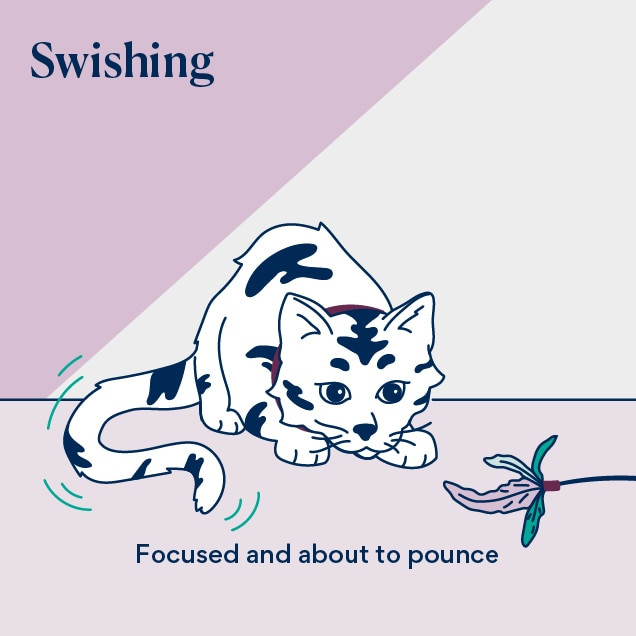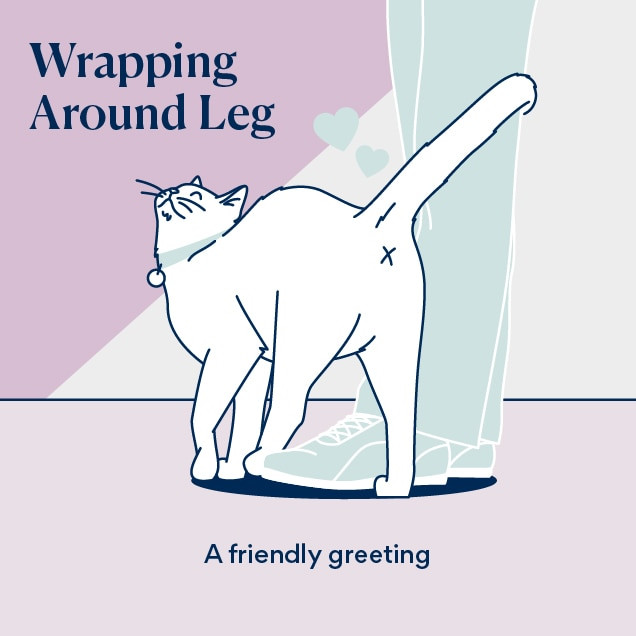Cats are complex creatures, and understanding their body language is key to building a strong bond. Ever wondered, “What Does It Mean If Cats Wag Their Tail?” At solcat.net, we’ll unravel the mystery behind feline tail movements, offering insights into your cat’s emotions and intentions. By learning to interpret your cat’s tail signals and other cues, you can create a happier, healthier relationship with your feline friend. This guide covers everything from happy tail wags to signs of irritation, providing you with the knowledge you need to better understand your cat’s tail language. Explore solcat.net for more expert advice on cat behavior and care, and discover valuable resources on understanding your cat’s emotions.
1. Why is Understanding a Cat’s Tail Meaning Important?
Understanding a cat’s tail movements is essential for interpreting their emotions and intentions. A cat’s tail is a powerful communication tool.
Decoding your cat’s tail language helps you gauge their feelings during interactions, identifying situations or environments that bring them joy or trigger fear. Recognizing tail signals can also aid in spotting early signs of illness or discomfort. By learning to interpret your cat’s tail language, you can better understand their needs, strengthen your bond, and provide them with a more comfortable and supportive environment.
- Improved Communication: Understanding tail language enhances communication between you and your cat.
- Early Detection of Issues: Recognizing changes in tail behavior can help identify health or emotional problems early on.
- Stronger Bond: Responding appropriately to your cat’s signals strengthens your relationship.
 illustration of a happy cat holding their tail straight up
illustration of a happy cat holding their tail straight up
Alt text: Happy cat with tail straight up, indicating a friendly and confident mood.
2. What Does It Mean When a Cat’s Tail Is Straight Up?
A straight-up tail on a cat typically indicates happiness, confidence, and a friendly approach.
When a cat holds its tail straight up, it signifies they are feeling social and confident, often approaching in a friendly manner. This is a common greeting among cats, especially between kittens and their mothers. According to a 1997 study by the University of Southampton, cats are more likely to approach a cat-shaped silhouette with a raised tail, indicating a positive and welcoming signal. If your cat approaches you with their tail up, it’s an invitation for interaction, making it an ideal time for petting or playing. At solcat.net, we emphasize recognizing these positive signals to enhance your interactions with your feline companion.
- Friendly Greeting: A straight-up tail often indicates a friendly greeting.
- Open to Interaction: It signals that the cat is receptive to petting or play.
- Confidence: This position shows the cat is feeling self-assured and comfortable.
3. What Does It Mean When a Cat’s Tail Looks Like a Question Mark or Hook?
A question mark or hook-shaped tail usually indicates that a cat is happy and inviting interaction.
If you notice your cat’s tail forming a question mark shape, with the tail standing upright and curling at the end, it’s a sign of happiness and a friendly invitation to engage. This tail position signals that your cat is in a good mood and is open to interaction. While it might be tempting to pet the curly-tipped tail, remember that cats typically prefer being petted around their facial glands, such as their cheeks, under the chin, and near their ears, as noted by feline behavior experts.
- Happiness: The question mark tail is a clear sign of a happy cat.
- Invitation: It indicates that the cat is inviting you to interact.
- Preferred Petting Spots: Remember to pet the cat where they enjoy it most, like the cheeks or under the chin.
 illustration of a cat
illustration of a cat
Alt text: Cat with tail in question mark shape, indicating happiness and invitation to play.
4. What Does It Mean When a Cat’s Tail Is Held Low to the Ground?
A tail held low to the ground can mean a cat is frightened, anxious, or feeling submissive.
When a cat’s tail is lowered below their back level, it often signals fear or anxiety. If the tail is tucked between their legs, the cat is likely experiencing intense fear or possibly pain. Recognizing these signs is crucial for addressing your cat’s distress. A calm and reassuring environment can help alleviate their anxiety. If the behavior persists, consulting a veterinarian is advisable to rule out any underlying health issues. Visit solcat.net for more insights on understanding and managing cat anxiety.
- Fear or Anxiety: A low tail often indicates fear or anxiety.
- Extreme Fear or Pain: A tail tucked between the legs signals intense fear or potential pain.
- Need for Reassurance: The cat needs a calm and reassuring environment.
5. What Does It Mean When a Cat’s Tail Is Puffed Up?
A puffed-up tail is a classic sign that a cat is startled, frightened, or feeling threatened.
If your cat’s tail suddenly becomes puffed up, resembling the iconic Halloween cat posture with an arched back, it indicates they are startled or frightened by a sudden threat. The hair stands on end, known as piloerection, making the cat appear larger as a defensive mechanism. This posture is a clear signal that the cat wishes to be left alone. Common triggers include other animals, unfamiliar visitors, or sudden loud noises. Decreasing these triggers can significantly reduce your cat’s stress. Approaching a cat in this state might be perceived as a further threat, potentially leading to aggression.
- Startled or Frightened: A puffed-up tail indicates the cat is scared.
- Defensive Reaction: The cat is trying to appear larger to ward off threats.
- Avoid Interaction: It’s best to give the cat space to calm down.
 illustration of a cat
illustration of a cat
Alt text: Cat with puffed-up tail and arched back, showing it is startled and on the defense.
6. What Does It Mean When a Cat’s Tail Is Wrapped Around Their Body?
A cat wrapping their tail around their body often means they are feeling frightened, defensive, in pain, or unwell.
When a cat sits or lies down with their tail wrapped snugly around their body, it’s a sign they are frightened, defensive, in pain, or generally feeling unwell. This posture indicates a need for comfort and security. It’s important to end any interaction and ensure their environment is free from stressors. If this behavior persists for more than a few days, consulting a veterinarian is crucial to rule out underlying pain or illness.
- Fear or Discomfort: Wrapping the tail indicates fear, defensiveness, or discomfort.
- Need for Comfort: The cat is seeking comfort and security.
- Potential Health Issue: Prolonged behavior warrants a vet visit.
7. Why Do Cats Wag Their Tails? Understanding Feline Tail Wagging
Cats wag their tails to express a range of emotions, much like dogs, but the meaning varies significantly based on the type of wag.
Cats use tail movements to communicate their feelings, but the interpretation differs from dogs. Understanding the nuances of a cat’s tail wag is crucial for accurately gauging their emotional state. Unlike dogs, who often wag their tails to indicate happiness, cats’ tail wags can signify a variety of emotions, including irritation, focus, and excitement. Recognizing these different types of “wagging” tail movements will help you better understand what your cat is trying to communicate.
- Expression of Emotions: Tail wags are a key way cats express their feelings.
- Varying Meanings: The meaning of a tail wag depends on the specific movement.
- Context is Important: Consider the situation and other body language cues.
8. What Does It Mean When a Cat Has Thrashing Tail Movements?
Thrashing tail movements in cats usually indicate irritation, annoyance, or anger.
When a cat thrashes their tail or thumps it aggressively on the ground, they are expressing irritation, annoyance, or anger. This behavior serves as a clear signal that something is bothering them. Understanding this cue can help you avoid escalating the situation. For example, if you are petting your cat and they begin to thrash their tail, it’s a sign to stop. Ignoring this warning may lead to hissing, growling, swatting, or even biting.
- Irritation or Anger: Thrashing tails indicate the cat is upset.
- Warning Sign: It’s a signal to stop what you’re doing.
- Potential Aggression: Ignoring the signal can lead to aggressive behavior.
 illustration of a cat trashing their tail
illustration of a cat trashing their tail
Alt text: Cat thrashing its tail, showing annoyance and irritation.
9. What Does It Mean When a Cat is Twitching the End of Its Tail?
Twitching at the end of a cat’s tail can indicate hunting mode, mild irritation, or frustration.
Cats twitch the end of their tails when they are hunting, playing, or experiencing mild irritation or frustration. To accurately interpret this behavior, it’s important to consider the context and look for additional clues about their mood. If they aren’t engaged in play or stalking something, the twitching tail likely indicates annoyance. Understanding this subtle signal can help you respond appropriately to your cat’s needs.
- Hunting or Playing: Twitching can indicate focus during play.
- Mild Irritation: It can also signal slight annoyance.
- Context Matters: Observe the situation to understand the cause.
10. What Does It Mean When a Cat Has Swishing Tails?
Swishing tails in cats can indicate intense focus, often seen when they are about to pounce.
When a cat slowly swishes their tail from side to side, it often indicates intense focus on something, such as a toy, another pet, or something outside. This behavior often precedes a pounce. Allowing your cat to engage in predatory behaviors like stalking and pouncing provides valuable enrichment and helps satisfy their natural instincts.
- Intense Focus: Swishing indicates the cat is focused on something.
- Predatory Behavior: It often precedes stalking or pouncing.
- Enrichment: Allowing this behavior provides mental stimulation.
 cat tail language illustration of a cat swishing their tail
cat tail language illustration of a cat swishing their tail
Alt text: Cat swishing its tail while focused, possibly preparing to pounce.
11. What Does It Mean When a Cat’s Tail Quivers?
Tail quivers in cats often indicate excitement or anticipation, but can also signify urine marking behavior.
A cat may quiver their tail when they are particularly excited to see you or another cat, indicating a positive emotional response. However, tail quivering can also signal urine marking, especially when accompanied by the cat holding their tail straight up and backing up against a vertical surface. Therefore, it’s important to consider the context to accurately interpret this behavior.
- Excitement: Quivering can show excitement upon greeting.
- Urine Marking: It can also signal a cat is marking their territory.
- Context is Key: Observe other behaviors to understand the meaning.
12. Why Do Cats Wrap Their Tails Around You?
Cats wrap their tails around you as a sign of greeting, affection, and willingness to interact.
Just as humans greet each other with handshakes or hugs, cats may greet by curling their tails around people or intertwining tails with other cats. Tail wrapping is an affiliative behavior that demonstrates a willingness to engage and form a bond. This gesture shows they are comfortable and seeking connection with you.
- Affectionate Greeting: Tail wrapping is a sign of affection.
- Bonding Behavior: It shows the cat wants to interact.
- Comfort and Security: The cat feels secure and comfortable around you.
 illustration of cat tail language when a cat wraps their tail around human legs
illustration of cat tail language when a cat wraps their tail around human legs
Alt text: Cat wrapping its tail around a person’s leg, indicating affection and comfort.
13. How Can I Improve My Understanding of Cat Body Language?
Improving your understanding of cat body language involves observing various cues beyond just the tail.
While the tail is highly expressive, understanding a cat’s emotional state requires considering multiple body language cues. Pay attention to their ears, eyes, posture, and vocalizations in addition to tail movements. Observing these signals in different contexts will provide a more comprehensive understanding of your cat’s feelings and intentions. Resources like solcat.net offer extensive guides and articles on cat behavior to further enhance your knowledge.
- Observe Multiple Cues: Consider ears, eyes, posture, and vocalizations.
- Context Matters: Understand the situation to interpret behavior correctly.
- Utilize Resources: Visit solcat.net for guides on cat behavior.
14. What Are Some Common Misconceptions About Cat Tail Language?
There are several common misconceptions about cat tail language that can lead to misunderstandings.
One common misconception is that a wagging tail always means happiness, as it often does in dogs. In cats, a wagging tail can indicate irritation or focus. Another misconception is that a puffed-up tail is always a sign of aggression; it can also indicate fear. Understanding the nuances of cat tail language helps avoid misinterpreting your cat’s emotions and intentions.
- Wagging Doesn’t Always Mean Happiness: In cats, it can mean irritation or focus.
- Puffed-Up Tail Isn’t Always Aggression: It can also indicate fear.
- Context is Crucial: Accurate interpretation requires considering the situation.
15. How Can I Use Tail Language to Strengthen My Bond With My Cat?
Understanding your cat’s tail language allows you to respond appropriately to their needs and emotions.
By learning to interpret your cat’s tail language, you can better respond to their needs and emotions, thereby strengthening your bond. For instance, if you notice your cat’s tail is thrashing, you’ll know to give them space and avoid petting them. Conversely, if their tail is straight up, you can approach them for interaction. Consistent, appropriate responses to their signals will help your cat feel understood and secure, fostering a deeper connection.
- Respond Appropriately: Tail language helps you react to your cat’s needs.
- Build Trust: Showing you understand their signals builds trust.
- Enhance Connection: Consistent, appropriate responses foster a deeper bond.
16. What Role Does Environment Play in a Cat’s Tail Behavior?
The environment significantly impacts a cat’s tail behavior, reflecting their comfort, stress, and alertness levels.
A cat’s environment significantly influences their tail behavior. In a comfortable, safe environment, a cat is more likely to display relaxed tail postures, such as a gentle sway or a question mark shape. In contrast, a stressful or unfamiliar environment may lead to defensive postures like a low or puffed-up tail. By creating a secure and enriching environment, you can promote positive tail behaviors and reduce stress-related signals.
- Comfort and Safety: A safe environment promotes relaxed tail postures.
- Stressful Environments: Stress can lead to defensive tail behaviors.
- Environmental Enrichment: A stimulating environment can reduce stress and promote positive signals.
17. Are There Differences in Tail Language Between Different Cat Breeds?
While basic tail language is consistent across cat breeds, some subtle variations exist due to physical differences and breed-specific temperaments.
Generally, basic tail language is consistent across different cat breeds. However, subtle variations may exist due to physical differences and breed-specific temperaments. For example, breeds with naturally shorter tails, like the Manx, may have limited tail movement, making it more challenging to interpret their signals. Understanding these nuances can help you better interpret your cat’s behavior, regardless of their breed.
- Basic Signals are Consistent: Most tail signals are the same across breeds.
- Physical Differences: Short-tailed breeds may have limited movement.
- Breed Temperament: Breed-specific traits can influence behavior.
18. How Accurate is Tail Language in Determining a Cat’s Mood?
Tail language is a valuable indicator of a cat’s mood but should be considered alongside other body language cues for an accurate assessment.
Tail language is a valuable indicator of a cat’s mood but shouldn’t be the sole factor in assessing their emotional state. For accurate interpretation, consider other body language cues such as ear position, eye dilation, body posture, and vocalizations. Combining these observations provides a more complete and reliable understanding of what your cat is feeling.
- Valuable Indicator: Tail language is a useful sign of a cat’s mood.
- Consider Other Cues: Ear position, eye dilation, and posture are also important.
- Comprehensive Assessment: Combining cues provides a more accurate understanding.
19. What Should I Do If My Cat’s Tail Behavior Suddenly Changes?
A sudden change in your cat’s tail behavior warrants close observation and, if persistent, a visit to the veterinarian to rule out underlying health issues.
If you notice a sudden change in your cat’s tail behavior, it’s essential to pay close attention. This could indicate a change in their emotional state or an underlying health issue. If the change persists for more than a day or two, or if you observe other signs of illness or distress, consult your veterinarian to rule out any medical problems.
- Pay Close Attention: Monitor any sudden changes in tail behavior.
- Rule Out Health Issues: Consult a vet if the change persists.
- Observe Other Symptoms: Look for additional signs of illness or distress.
20. What Are Some Resources for Learning More About Cat Body Language?
There are numerous resources available to help you learn more about cat body language, including websites like solcat.net, books, and consultations with feline behaviorists.
To further enhance your understanding of cat body language, numerous resources are available. Websites like solcat.net offer articles, guides, and expert advice on cat behavior. Books on feline behavior provide in-depth information, and consulting with a certified feline behaviorist can offer personalized insights and solutions.
- Websites: Solcat.net offers articles and guides on cat behavior. Address: 950 Alaskan Way, Seattle, WA 98104, United States. Phone: +1 (206) 386-4000. Website: solcat.net.
- Books: Numerous books provide detailed information on feline behavior.
- Behaviorists: Consult with a certified feline behaviorist for personalized advice.
Understanding your cat’s tail language is a rewarding journey that deepens your connection and improves their quality of life. At solcat.net, we are dedicated to providing you with the resources and knowledge you need to be the best cat parent possible.
FAQ: Decoding Your Cat’s Tail – Common Questions Answered
1. Is a wagging tail always a sign of happiness in cats?
No, unlike dogs, a wagging tail in cats doesn’t always mean happiness. It can also indicate irritation, focus, or conflict.
2. What does it mean if my cat’s tail is twitching?
A twitching tail can mean your cat is hunting, playing, or feeling mildly irritated or frustrated.
3. Why does my cat puff up their tail?
A puffed-up tail usually means your cat is startled, frightened, or trying to appear larger to ward off a threat.
4. What does it mean when a cat wraps its tail around you?
Wrapping the tail around you is a sign of affection, comfort, and a willingness to interact.
5. Is tail language the only way cats communicate?
No, cats use a combination of tail movements, ear position, eye dilation, body posture, and vocalizations to communicate.
6. What does it mean if my cat holds its tail straight up?
A straight-up tail indicates happiness, confidence, and a friendly approach.
7. Why does my cat lower its tail to the ground?
A low tail often signals fear, anxiety, or feeling submissive.
8. What should I do if my cat’s tail behavior suddenly changes?
Monitor the change and consult a veterinarian if it persists or if you observe other signs of illness or distress.
9. Are there differences in tail language between cat breeds?
While basic signals are consistent, subtle variations may exist due to physical differences and breed-specific temperaments.
10. How can I improve my understanding of cat body language?
Observe multiple cues, consider the context, and utilize resources like solcat.net for guides on cat behavior.
We hope this guide has helped you better understand your cat’s tail language. Remember to visit solcat.net for more valuable insights and resources on cat behavior and care. Your feline friend will thank you for it!
